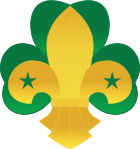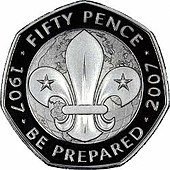Scouting began in 1907 when Robert Baden-Powell, Lieutenant General in the British Army, held the first Scouting encampment at Brownsea Island in England. Baden-Powell wrote the principles of Scouting in Scouting for Boys (London, 1908), based on his earlier military books, with influence and support of Frederick Russell Burnham (Chief of Scouts in British Africa), Seton of the Woodcraft Indians, Smith of the Boys' Brigade, and his publisher Pearson. During the first half of the 20th century, the movement grew to encompass three major age groups each for boys (Cub Scout, Boy Scout, Rover Scout) and, in 1910, a new organization, Girl Guides, was created for girls (Brownie Guide, Girl Guide and Girl Scout, Ranger Guide).
The movement employs the Scout method, a program of informal education with an emphasis on practical outdoor activities, including camping, woodcraft, aquatics, hiking, backpacking, and sports. Another widely recognized movement characteristic is the Scout uniform, by intent hiding all differences of social standing in a country and making for equality, with neckerchief and campaign hat or comparable head wear. Distinctive uniform insignia include the fleur-de-lis and the trefoil, as well as merit badges and other patches.
In 2007, Scouting and Guiding together had over 38 million members in 216 countries. The two largest umbrella organizations are the World Organization of the Scout Movement (WOSM), for boys-only and co-educational organizations, and the World Association of Girl Guides and Girl Scouts (WAGGGS), primarily for girls-only organizations but also accepting co-educational organizations. That year marked the centenary of Scouting world wide, and member organizations planned events to celebrate the occasion.
From Wikipedia.org.com
Growth
As a military officer, Baden-Powell was stationed in British India and Africa in the 1880s and 1890s. Since his youth, he had been fond of woodcraft and military scouting, and—as part of their training—showed his men how to survive in the wilderness. He noticed that it helped the soldiers to develop independence rather than just blindly follow officers' orders.[1]
In South Africa during the Second Boer War, Baden-Powell was besieged in the small town of Mafeking by a much larger Boer army (the Siege of Mafeking).[2] The Mafeking Cadet Corps was a group of youths that supported the troops by carrying messages, which freed the men for military duties and kept the boys occupied during the long siege. The Cadet Corps performed well, helping in the defense of the town (1899–1900), and were one of the many factors that inspired Baden-Powell to form the Scouting movement.[3][4][5] Each member received a badge that illustrated a combined compass point and spearhead. The badge's logo was similar to the fleur-de-lis that Scouting later adopted as its international symbol.[6]
In the United Kingdom, the public followed Baden-Powell's struggle to hold Mafeking through newspapers, and when the siege was broken, he had become a national hero. This rise to fame fueled the sales of a small instruction book he had written about military scouting, Aids to Scouting.[7]
On his return to England, he noticed that boys showed considerable interest in the book, which was used by teachers and youth organizations.[8] He was suggested by several to rewrite this book for boys, especially during an inspection of the Boys' Brigade, a large youth movement drilled with military precision. Baden-Powell thought this would not be attractive and suggested that it could grow much larger when scouting would be used.[9] He studied other schemes, parts of which he used for Scouting.
In July 1906, Ernest Thompson Seton sent Baden-Powell a copy of his book The Birchbark Roll of the Woodcraft Indians. Seton, a British-born Canadian living in the United States, met Baden-Powell in October 1906, and they shared ideas about youth training programs.[10][11] In 1907 Baden-Powell wrote a draft called Boy Patrols. In the same year, to test his ideas, he gathered 21 boys of mixed social backgrounds (from boy's schools in the London area and a section of boys from the Poole, Parkstone, Hamworthy, Bournemouth, and Winton Boys' Brigade units) and held a week-long camp in August on Brownsea Island in Poole Harbour, Dorset, England.[12] His organizational method, now known as the Patrol System and a key part of Scouting training, allowed the boys to organize themselves into small groups with an elected patrol leader.[13]
In the autumn of 1907, Baden-Powell went on an extensive speaking tour arranged by his publisher, Arthur Pearson, to promote his forthcoming book, Scouting for Boys. He had not simply rewritten his Aids to Scouting, but left out the military aspects and transferred the techniques (mainly survival) to non-military heroes: backwoodsmen, explorers (and later on, sailors and airmen).[1] He also added innovative educational principles (the Scout method) by which he extended the attractive game to a personal mental education.[11]
Scouting for Boys first appeared in England in January 1908 as six fortnightly installments, and was published in England later in 1908 in book form. The book is now the fourth-bestselling title of all time,[14] and is now commonly considered the first version of the Boy Scout Handbook.[15]
At the time, Baden-Powell intended that the scheme would be used by established organizations, in particular the Boys' Brigade, from the founder William A. Smith.[16] However, because of the popularity of his person and the adventurous outdoor game he wrote about, boys spontaneously formed Scout patrols and flooded Baden-Powell with requests for assistance. He encouraged them, and the Scouting movement developed momentum. As the movement grew, Sea Scout, Air Scout, and other specialized units were added to the program.[17][18]
From wikipedia.org.com


